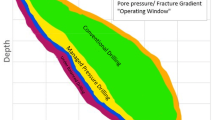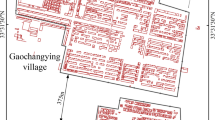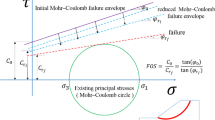Abstract
The transformation of large open pit mines into deep underground mines brings new challenges and difficulties that put the safety and operation of the mine at risk. The distribution and fluctuations of stress on the pillars and the arching are two of the main factors that influence the probability of suffering a catastrophic event in the mine. This article focuses on the study of the influence of the arching in creating a stress depletion zone that is identified with a dilation front, which in turn is ultimately responsible for the emergence of a cavity that propagates towards the upper surface of the system. Results indicate that significant arching occurs in the zones located above the active draw-points, while stress is concentrated around them. When single draw-point is operated the stress screening is significative because the large cavity created by the arching. This screening is dramatically reduced when two neighbouring draw-points are operated simultaneously. The increase in the size of the screening zone is associated with a decrease in the granular packing. By counterbalacing the particles flow from top surface we find a relationship between the cavity’s volume and the volume of removed material. A discussion of the effect of the operation method of two neighbouring draw-points on the effective arch size is included.
Highlights
-
Simple and effective experimental technique to visualize forces redistribution above extraction level.
-
Arches motion creates stress attenuation zone in underground mining.
-
The stress attenuation zone is where the local density decreases.
-
Mineral extraction drives density change, causing arches motion and stress attenuation.
-
Stress attenuation zone volume depends logarithmically on extracted mineral volume.







Similar content being viewed by others
References
Bergmark JE (1975) Calculation of drift spacing and rign burden for sublevel caving [Note RU 75–16]. LKAB.-Forschungsbericht, Malmberget
Brown ET (2003) Block caving geomechanics. In: The international caving study stage I-1997 through 2000. Julius Kruttschnitt Mineral Research Centre, Indooroopilly, QLD, The University of Queensland, Australia
Castro R, Gomez R, Pierce M, Canales J (2020) Experimental quantification of vertical stresses during gravity flow in block caving. Int J Rock Mech Min Sci 127:104237
Chen G (1997) Stochastic modeling of rock fragment under gravity. Int J Rock Mech Min Sci 34:323–331
Deutsch GP, Clyde DH (1967) Flow and pressure of granular materials in silos. J Eng Mech Div 93(dec, Nr. 6):103–125
Gåsvik K (2002) Optical metrology. Wiley
Gatt FC (1973) Flow of spheres and near spheres in cylindrical vessels/Australian Atomic Energy Commission Research Establishment, Lucas Heights. (AAEC/E–273).—Forschungsbericht
Janelid I, Kvapil R (1966) Sublevel caving. Int J Rock Mech Min Sci 3:129–153
Jayanthu S, Singh TN, Singh DP (2004) Stress distribution during extraction of pillars in a thick coal seam. Rock Mech Rock Eng 37:171–192
Komatsu TS, Inagaki S, Nakagawa N, Nasuno (2001) Creep motion in a granular pile exhibiting steady surface flow. Phys Rev Lett 86:1757–1760. https://doi.org/10.1103/PhysRevLett.86.1757
Kong P, Jiang L, Shu J, Wang L (2019) Mining stress distribution and fault-slip behavior: a case study of fault-influenced longwall coal mining. Energies 12:2494
Kuchta ME (2002) A revised form of the Bergamrk-Roos equation for describing the gravity flow of broken rocks. Miner Resour Eng 11:349–360
Kvapil R (1965) Gravity flow of granular material in hoppers and bins. Int J Rock Mech Min Sci 2:277–304
Majmudar TS, Behringer RP (2005) Contact force measurements and stress-induced anisotropy in granular materials. Nature 435:1079–1082
Melo F, Vivanco F, Fuentes C, Apablaza V (2007) On drawbody shapes: from Bergmark Roos to kinematic models. Int J Rock Mech Min Sci 44:77–86
Melo F, Vivanco F, Fuentes C, Apablaza V (2008) Kinematic model for quasi static granular displacements in block caving: dilatancy effects on drawbody shapes. Int J Rock Mech Min Sci 45:248–259
Melo F, Vivanco F, Fuentes C (2009) Isolated extracted and movement zones from kinematic and plasticity models compared to scaled models. Int J Rock Mech Min Sci 46:731–737
Michell JH (1900) On Distributions of Stress in Three Dimensions. Proc Lond Math Soc 32:44–45
Pariseau WG, Pfleider EP (1968) Soil plasticity and the movement of materials in ore passes. Trans Soc Min Eng Am Inst Min Metall Pet Eng 241:42–56
Pierce ME (2019) Forecasting vulnerability of deep extraction level excavations to draw-induced cave loads. J Rock Mech Geotech Eng 11:527–534
Ramesh K (2008) Photoelasticity. In: Sharpe W (ed) Handbook of experimental solid mechanics. Spinger Science+Business Media LLC, New York, pp 701–742
Rustan A (2000) Gravity flow of broken rock-what is known and unknown. In: Proceedings of MassMin 2000, pp 557–567
Selldén H, Pierce M (2004) PFC3D modeling of flow behaviour in sublevel caving. In: 4th International Conference and exhibition on mass mining, Instituto de Ingenieros de Chile, pp 201–214
Sharrock G, Beck D, Booth G, Sandy M (2004) Simulating gravity flow in sub-level caving with cellular automata. In: 4th International Conference and exhibition on mass mining, Instituto de Ingenieros de Chile, pp 189–194
Timoshenko S, Goodier JN (1951) Theory of elasticity. McGraw-Hill, New York
Vivanco F, Melo F (2013) The effect of rock decompaction on the interaction of movement zones in underground mining. Int J Rock Mech Min Sci 60:381–388
Vivanco F, Watt T, Melo F (2011) Granular flow models and dilation front propagation applied to underground mining. Int J Rock Mech Min Sci 48:406–411
Vivanco F, Rica S, Melo F (2012) Dynamical arching in two dimensional granular flow. Granular Matter 14:563–576
Vyazmensky A, Stead D, Elmo D, Moss A (2010) numerical analysis of block caving-induced instability in large open pit slopes: a finite element/discrete element approach. Rock Mech Rock Eng 43:21–39
Wilson AD, Purba AM, Sjadat A (2016) Progressing cave performance into the later stages of the Deep Ore Zone mine. In: Proceedings of the Seventh International Conference and exhibition on mass mining, pp 285–292
Zandman F, Redner S, Dally JW (1977) Photoelastic coatings, SESA Monograph No 3. Iowa State University Press
Zhang P, Gearhart D, Dyke MV, Su D, Esterhuizen E, Tulub B (2019) Ground response to high horizontal stresses during longwall retreat and its implications for longwall headgate support. Int J Min Sci Technol 29:27–33
Acknowledgements
F. Melo acknowledges the support from DICYT University of Santiago through project: USA2055-042031MH-POSTDOC. The support of LIA MSD: France-Chile Laboratoire International Associé, “Matière: Structure et Dynamique” is greatly acknowledged.
Author information
Authors and Affiliations
Corresponding author
Ethics declarations
Conflict of interest
The authors declare that they have no conflict of interest.
Additional information
Publisher's Note
Springer Nature remains neutral with regard to jurisdictional claims in published maps and institutional affiliations.
Rights and permissions
Springer Nature or its licensor (e.g. a society or other partner) holds exclusive rights to this article under a publishing agreement with the author(s) or other rightsholder(s); author self-archiving of the accepted manuscript version of this article is solely governed by the terms of such publishing agreement and applicable law.
About this article
Cite this article
Vivanco-Avaria, F.J., Melo-Hurtado, F.E. Arching Propagation and Safety in Underground Mining. Rock Mech Rock Eng 56, 3611–3620 (2023). https://doi.org/10.1007/s00603-023-03251-0
Received:
Accepted:
Published:
Issue Date:
DOI: https://doi.org/10.1007/s00603-023-03251-0




